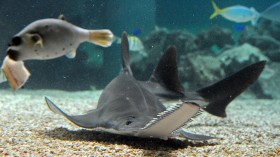A new study of skeletal remains discovered in an island cave reveals that the first human settlers of Sicily ate little seafood.
Researchers analyzed the skeletons found in 1972 in Grotta d'Oriente cave on the modern-day island of Favignana, Italy. The island was once connected to Sicily by a land bridge, reported LiveScience.
The bone fragments discovered in the cave belonged to an adult male and two adult females. The research team extracted the mitochondrial DNA from the skeletal remains. DNA analysis revealed the time when modern humans reached these islands in the Mediterranean basin.
"The definitive peopling of Sicily by modern humans only occurred at the peak of the last ice age, around 19,000 -26,500 years ago, when sea levels were low enough to expose a land bridge between the island and the Italian peninsula," study author Marcello Mannino, from the Max Planck Institute for Evolutionary Anthropology, Germany, said in a statement.
Experts also analyzed the chemical composition of the human remains to uncover their diets. Despite living on islands in the Mediterranean, the first human settlers of Sicily maintained their lifestyle as hunter-gatherers and fed on terrestrial animals like deer and boar. They made little use of marine resources, with less than 20 percent of seafood consumption.
Mannino suggests two reasons as to why they ate little seafood. One reason he cites is that the Mediterranean does not offer nutrient-rich food, as there aren't many fish in the sea. The second reason is that these early Homo sapien settlers didn't have the technology to do much fishing, the report in LiveScience said.
"These findings have crucial implications for studies of the role of seafood in the diet of Mediterranean hunter-gatherers," the researchers concluded in the paper.
The findings of the study, "Origin and Diet of the Prehistoric Hunter-Gatherers on the Mediterranean Island of Favignana (Ègadi Islands, Sicily)", are published in the journal PLOS ONE.
© 2024 NatureWorldNews.com All rights reserved. Do not reproduce without permission.
![Severe Thunderstorm Alert: Tornadoes, Damaging Winds and Hail Possible from Upper Ohio Valley to Northeast US [NWS]](https://1471793142.rsc.cdn77.org/data/thumbs/full/70161/280/157/50/40/severe-thunderstorm-alert-tornadoes-damaging-winds-and-hail-possible-from-upper-ohio-valley-to-northeast-us-nws.jpg)




